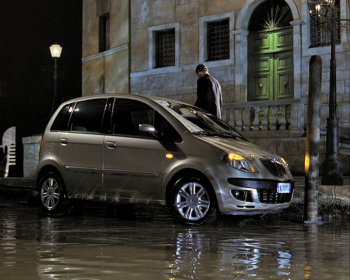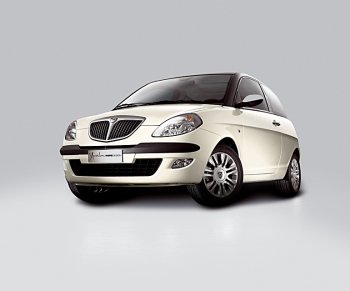|
As the main
sponsor of the 63rd Venice International Film Festival,
Lancia will present an exclusive selection of the most
beautiful cars of all time, chosen from the Lancia
Collection, at the Hotel Excelsior on the opening day of the
Festival.
Today, the
four-wheeled “divas” at the Lido will include: the Lancia
Astura coupé Pinin Farina (1939) which once belonged to
Galeazzo Ciano; the Lancia Aurelia B24 America Convertible
(1957), which became a symbol of the young, carefree Italy
of the 1960s, thanks to Dino Risi’s famous film Il Sorpasso
(The Easy Life), with Vittorio Gassman and Jean-Louis
Trintignant (1961); and a Lancia Aprilia Cabriolet Pinin
Farina (1947), rescued from Hollywood in the 1980s. From
history to the cinema, and from the world of racing: the
Lancia D50 Formula 1 (1954) is the car that generated the
Scuderia Ferrari, in which the young Argentinean driver Juan
Manuel Fangio won the world championship in 1956.
Celebrations for
the first 100 years of Lancia set for September 4 and 5
The most
important days for the Lancia brand will be September 4 and
5, when Lancia welcomes its dealers and the press, to
present its glorious past and to look forward to the its
future. On September 4 there will be a gala dinner for 900
guests, in the unusual and striking setting of the Sorlini
Hangar at the Lido. A number of the brand’s historical and
current models will be on display, and the company’s top
management will be present to celebrate Lancia’s centenary
in great style, with fireworks and music. From 11 pm, the
party will be open to the community of the 63rd Venice
International Film Festival.
On Tuesday 5, in
the prestigious venue of the Teatro La Fenice, Lancia will
present the challenges and strategies of the coming years to
the international motoring and economic media. In the
afternoon, in the Lancia exhibition area in front of the
Casino at the Lido, the Ypsilon Hour will strike, bringing a
surprise for the audience in Venice.
Lancia and
films, a historical partnership
Lancia has
always had a very close relationship with the film world,
since the start of the twentieth century. In the early days
of the Turin silent film industry, cars, and Lancias in
particular, were behind the rise of the great Italian male
and female film stars, and Emilio Ghione, for one, used
Lancias in his films. Later, in the so-called “white
telephone” films of the Thirties, this type of car was
chosen both to accompany the dreams of Italians “beyond the
threshold of one thousand lire a month”, and almost to
represent the key giving access to the modern world. Even
more recently, Lancia cars have co-starred in a number of
highly successful films. Since the 1950s, cars built by the
Turin company have appeared on the screen often, and in some
cases they have created the style and icons of particular
periods.
|
 |
|
The most important days for the
Lancia brand will be September 4 and 5, when Lancia
welcomes its dealers and the press, to present its
glorious past and to look forward to the its future. |
|
 |
|
“With a similar background, it was inevitable that
we should choose to be a partner of the 63rd Venice
International Film Festival,” said Olivier François,
Lancia Brand Manager. “It is a great honour for us
to be part of the Festival. It is the ideal setting
to celebrate the first one hundred years of our
company and to look forward to the future, in front
of an international audience.” |
|
|
 |
|
As the main sponsor of the 63rd Venice International
Film Festival, Lancia will present an exclusive
selection of the most beautiful cars of all time,
chosen from the Lancia Collection, at the Hotel
Excelsior on the opening day of the Festival. |
|
|
The period after
the World War II in Italy is the setting for a series of
films based on the novels of Guareschi, and a Lancia Astura,
an elite, luxury car produced in the 1930s, appeared in Il
piccolo mondo di Don Camillo (1952). I soliti Ignoti of 1958
featured a Lancia Aurelia B10, a car that confirmed the
brand’s philosophy after the war years, and was the direct
forebear of the Aurelia B24 Convertible, the star of Il
sorpasso (1962) by Dino Risi, with Catherine Spaak, Vittorio
Gassman and Jean-Louis Trintignant, and certainly the
best-known car in Italian film history. Claude Lelouch made
the interesting decision to make a racing version of the
Flavia Coupé sports car one of the ‘stars’ of A Man and a
Woman in 1966, while a Lancia Thema was chosen for the less
well-known sequel A Man and a Woman: 20 years later, in
1986.
Contemporary
cars are used in period films, and it is significant that
Lancia is represented by the best output of the day, as in
the case of the Lancia Artena in the film Mussolini ultimo
atto of 1974. Among more eclectic films, like Dario
Argento’s Profondo Rosso of 1975, Lancia was present with
the Fulvia Coupé, an outstanding model for its brilliant
performance, elegance and beautifully finished interior.
Even the film Herbie goes to Montecarlo of 1977 paid tribute
to Lancia when two Lancia models, the Scorpion and the
Stratos, were called on to express different missions,
appearing in two distinct but real roles. In 1981, Alain
Delon starred in Pour la peau d’un flic in a Lancia Delta,
recently elected Car of the Year; subsequent versions of
this model with permanent four-wheel drive later set a still
unbeaten record, by winning six consecutive World Rally
Championship titles, from 1987 to 1992.
More recently,
the Lancia Ypsilon has starred in a short film Affinità
elettive (2003) by Gabriele Muccino, with Nicoletta Romanoff
and Milena Mancini. The Lancia Thesis also starred in an
original short film, The Call (2006) by Antoine Fuqua, which
marked Pirelli’s debut in cinema. The Lancia flagship is the
powerful, quiet saloon that takes the exorcist (John
Malkovich) to his appointment with Evil.
“With a similar
background, it was inevitable that we should choose to be a
partner of the 63rd Venice International Film Festival,”
said Olivier François, Lancia Brand Manager. “It is a great
honour for us to be part of the Festival. It is the ideal
setting to celebrate the first one hundred years of our
company and to look forward to the future, in front of an
international audience.”
All the Lancias
at Venice
This morning the
following Lancias will be on display in front of the Hotel
Excelsior: Artena Cabrio (1932); Aprilia Saloon 1st
series (1937); Aurelia GT B20 (1951); D50 Formula 1 (1954);
D25 Sport Spider (1954); Flaminia Saloon First Series
(1959); Flaminia 2.8 Coupé Pininfarina (1965); Fulvia Coupé
(1967); Flavia Coupé 1.8 (1967); Gamma 2.0 Coupé (1978);
Beta Montecarlo Spider (1980); Delta HF Integrale 16v
Martini (1991).
These models
have come to represent the different periods of Italian
history and society. And to give a special significance to
the inauguration party, an Astura Coupé Pininfarina (1939),
Aprilia Cabriolet Pininfarina (1947), Aurelia B24 America
Convertible (1957), and Flaminia GT Touring Convertible
(1964), will parade like divas of the past, driven by
private collectors and members of the Lancia Club Italia. A
spectacular debut chosen by Lancia as a tribute to the
Italian film industry. An Aurelia Granturismo 2500 Spider
B24 (1955) will be on display throughout the 63rd
International Film Festival, inside the Lancia exhibition
area in front of the Casino. Over thirty cars from the
current Lancia range that includes the Diva, Phedra and
Thesis – the latter in the bicolore versions was inspired by
the famous two-tone Flaminia – will also be on hand as the
official vehicles for the stars staying at the Lido.
|
|
|
|